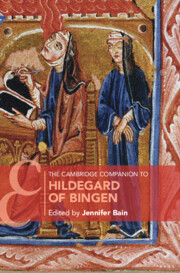Book contents
- The Cambridge Companion to Hildegard of Bingen
- The Cambridge Companion to Hildegard of Bingen
- Copyright page
- Dedication
- Contents
- Figures
- Tables
- Music Examples
- Contributors
- Acknowledgments
- Introduction
- Part I Life and Monastic Context
- Part II Writings and Reputation
- Part III Music, Manuscripts, Illuminations, and Scribes
- Chapter 10 Music, Liturgy, and Intertextuality in Hildegard of Bingen’s Chant Repertory
- Chapter 11 The Ordo virtutum and Benedictine Monasticism
- Chapter 12 Picturing Hildegard of Bingen’s Sight: Illuminating Her Visions
- Chapter 13 Hildegard of Bingen and Her Scribes
- Select Bibliography
- Index
- Cambridge Companions To …
- References
Chapter 13 - Hildegard of Bingen and Her Scribes
from Part III - Music, Manuscripts, Illuminations, and Scribes
Published online by Cambridge University Press: 28 October 2021
- The Cambridge Companion to Hildegard of Bingen
- The Cambridge Companion to Hildegard of Bingen
- Copyright page
- Dedication
- Contents
- Figures
- Tables
- Music Examples
- Contributors
- Acknowledgments
- Introduction
- Part I Life and Monastic Context
- Part II Writings and Reputation
- Part III Music, Manuscripts, Illuminations, and Scribes
- Chapter 10 Music, Liturgy, and Intertextuality in Hildegard of Bingen’s Chant Repertory
- Chapter 11 The Ordo virtutum and Benedictine Monasticism
- Chapter 12 Picturing Hildegard of Bingen’s Sight: Illuminating Her Visions
- Chapter 13 Hildegard of Bingen and Her Scribes
- Select Bibliography
- Index
- Cambridge Companions To …
- References
Summary
This chapter demonstrates several ways in which scribes and the scriptorium were central to life in Hildegard of Bingen’s community, perhaps even before the women departed from the Disibodenberg. Under the probable supervision of Hildegard’s provost the monk Volmar, nuns in Hildegard’s scriptorium were responsible for the copying, and hence the preservation of Hildegard’s writings, from the letter collections of the earlier attested periods of scribal activity to the feverish activity of the final decade or so of Hildegard’s life, to the compilation and preparation of the Riesencodex, Wiesbaden, Hochschul- und Landesbibliothek RheinMein, MS 2, which forms a kind of critical edition of her writings. Many scribal hands were involved in the work, suggesting that copying was an important part of monastic discipline on the Rupertsberg. This essay introduces the major features of the house style and some of the problems of studying scribal practices, focusing on the habits of one scribe who worked on two copies of Scivias. A complete list of the manuscripts of Hildegard’s trilogy surviving in Rupertsberg copies is provided as well.
Keywords
- Type
- Chapter
- Information
- The Cambridge Companion to Hildegard of Bingen , pp. 280 - 299Publisher: Cambridge University PressPrint publication year: 2021



